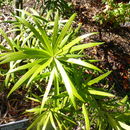en
names in breadcrumbs


The wood is used in making furniture, musical instruments, carvings, and paper.
Podocarpus neriifolius is a species of conifer in the family Podocarpaceae. It grows 10–15m tall, though very occasionally taller, in tropical and subtropical wet closed forests, between 650m and 1600m altitude.[2] In Cambodia however it grows in a dwarf form some 2–4m tall, at Bokor, some 1000m elevation.
It is found in India, Bangladesh, Nepal, China, Myanmar, Thailand, Laos, Cambodia, Vietnam, Malaysia, Indonesia, Brunei, the Philippines, Papua New Guinea, Solomon Islands, Fiji and Bhutan
Its common name in Khmer is srô:l.[2]
It has a yellowish wood, used in construction in Cambodia, where it is graded 2nd category (not as good as 1st, but above others).[2]
Podocarpus neriifolius is a species of conifer in the family Podocarpaceae. It grows 10–15m tall, though very occasionally taller, in tropical and subtropical wet closed forests, between 650m and 1600m altitude. In Cambodia however it grows in a dwarf form some 2–4m tall, at Bokor, some 1000m elevation.
It is found in India, Bangladesh, Nepal, China, Myanmar, Thailand, Laos, Cambodia, Vietnam, Malaysia, Indonesia, Brunei, the Philippines, Papua New Guinea, Solomon Islands, Fiji and Bhutan
Its common name in Khmer is srô:l.
It has a yellowish wood, used in construction in Cambodia, where it is graded 2nd category (not as good as 1st, but above others).